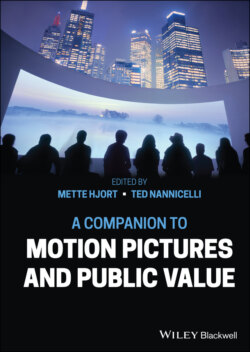Читать книгу A Companion to Motion Pictures and Public Value - Группа авторов - Страница 59
Esfir Shub
Оглавление“A person who cannot edit should not make films at all.”
Esfir Shub (as translated by Anastasia
Kostina 2016, 22)
Esfir Shub (1894–1959), Soviet director–editor, is often credited with the invention of the “compilation” film—a form of documentary constructed entirely in editing, from archival footage.10 Her work demonstrates the ways that ideas are created in editing. That Shub’s own writing tends to de-center the individual’s brain and acknowledge the work of hands, tools, and associates in creative process may have been partially responsible for her erasure from film theorizing. This points to the urgency of recalibrating our understanding of filmmaking creativity for the appropriate recognition of women in film history.
Shub began her career in the early 1920s, re-editing imported films to make them “appropriate” for Soviet audiences. “Western and American films had to be ideologically corrected, which meant changing the plot and the editing structure of the film, as well as writing new intertitles” (Shub 1927, translated in Gadassik 2018, 3). By turning celebrations of capitalism into cautionary tales about its excesses, Shub developed expertise in writing (or re-writing) through editing to create new meanings from film footage. Building on this skill, her celebrated 1927 full-length documentary The Fall of the Romanov Dynasty is made entirely in editing.
The process of locating, sifting through, compiling, reshooting, reframing, enlarging, matching speech, action, and movement within the frame of pieces of film originally shot by many different cameramen—all of this Shub did in order to produce a coherent and fluid narrative…with documents that had been made for an entirely different, if not the opposite, purpose. (Kaganovsky 2018, 7)
However, Shub’s “transformative use of footage” did not “fit neatly into the established picture of a director as someone staging and managing a film set…She could not get directorial credit until colleagues intervened on her behalf” (Gadassik 2018, 2–3). Or, as Stollery reports it: “After the film was released controversy arose because Sovkino initially refused to recognize Shub’s author’s rights and pay corresponding royalties” (Stollery 2002, 96). It is not likely, in her time, that her radical incursion into film form was seen as “merely” the work of hands. Editing was understood by the Soviets to be the medium-specific attribute that distinguished cinema from all other art forms and the most important aspect of filmmaking. “Shub’s belief that editing is the primary creative force in cinema’s visual grammar is consistent with the theoretical underpinnings of the Soviet avant-garde…” (Kostina and Dyshlyuk 2016, 10). Further, even within this hotbed of montage creativity, Shub’s “vision of archival compilation…is quite original” (Kostina and Dyshlyuk 2016, 10), and originality is not usually a reason why creative people get overlooked. So, it is probably not her work’s originality that impedes Shub’s occupation of a more significant position in film history.11 Perhaps then, it is the compilation film form itself, particularly because it “could be perceived as an extension of the type of work usually performed by invisible, uncredited women.” (Stollery 2002, 96). This form of erasure seems the most plausible explanation. Shub is undoubtedly not the first case of editors and women being disappeared, and she is also far from the last.
However, Shub’s own stance in relation to this question of a creative authorship credit may also, Stollery argues, have been a factor. “The compilation led to a cultural theory where author’s autonomy was drastically reduced, and the film archive became the ultimate ‘author’, the matrix out of which films were generated” (2002, 94). It is clear from the few translations of her writings into English (see Petric 1978; Kostina and Dyshlyuk 2016; Gadassik 2018) that Shub sees her work as an instance of distributed creativity. She “insisted that ‘mastery’ in filmmaking was not a matter of personal genius: ‘It is all a matter of technique…of aims and method. That is what we must talk about’”. (Shub as quoted in Stollery 2002, 93). Unlike her colleague Sergei Eisenstein who “was accused by various LEF-ists12 of a multitude of interrelated sins” (Stollery 2002, 92) to do with developing an individual and individualist style, Shub “was actively rejecting the notion of the artist as Romantic, solitary genius” (Stollery 2002, 94). In a 1972 documentary about Shub, director Grigori Kozintsev describes Shub’s ideas in terms that are highly resonant with a distributed cognition framework: “For Shub, he notes, montage was not the mere act of gluing together pieces of film, nor was it merely a way to tell a story; montage was a way of thinking, of expressing thought on the screen” (Kaganofsky 2018, 7). Or, as Shub writes: “unexpected solutions come up when you hold film stock in your hands. Just like letters: they are born on the top of the pen” (Shub as quoted in Petric 1978, 429). In other words, ideas generation is distributed between Shub, her tools (e.g., strips of film), and the images in the filmed material, at least.
Questions arise from this brief study of Shub about why ideas of creative authorship have remained so persistently individualistic. Cultural desires for a single creative artist to laud and the economic/marketing efficiencies of recognizing a single person are not the only reasons distributed creativity is left out of film history. Both poor, overly individualist assumptions about the nature of cognition, and the element of unconscious sexism are also significant. Stollery challenges us to take the questions seriously, noting: “It is significant that it was a woman who pioneered this new genre based upon a repudiation of established notions of authorship” (2002, 96).
